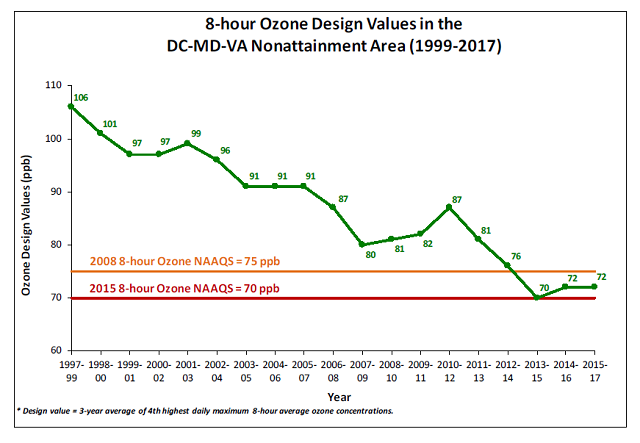The Metropolitan Washington Air Quality Committee (MWAQC) at the Metropolitan Washington Council of Governments (COG), approved a plan yesterday that demonstrates the region’s achievement in attaining the U.S. Environmental Protection Agency’s (EPA) 2008 standard for ground-level ozone pollution, and details how officials will continue to meet this air quality standard in the future.
Ground-level ozone is a colorless gas created when air pollutants react on hot, sunny, summer days. Sensitive groups such as people with lung disease, children and older adults, and people who are active outdoors may experience adverse health effects when ozone levels are elevated.
The Ozone Maintenance Plan features air quality data and emissions inventories that forecast even lower emissions in the future.
In 2012, the EPA ruled that the region had not met its standard for reducing ground-level ozone. Local and state officials have worked together through MWAQC to comply with the EPA standard through a variety of actions, including reducing emissions from power plants and passenger vehicles and implementing programs that help area residents improve energy efficiency and enhance renewable energy use. The region met the 2008 standard (75 parts per billion) in 2015.
EPA first established standards for ground-level ozone in the 1970s, and continues to lower the standards to protect human health and the environment. In 2015, the EPA revised the standards for ground-level ozone to 70 parts per billion, a level that is more protective of public health. While today’s action shows metropolitan Washington is meeting the older 75 ppb standard, current data indicates that the region does not yet meet the updated standards, so actions still need to be taken to further clean the air.

Source: COG; Data preliminary as of December 20, 2017
“It has taken collaboration on the part of residents, businesses, and all levels of government to get this far in improving the region’s air quality, but there’s more to be done,” said Hans Riemer, Metropolitan Washington Air Quality Committee Chairman and Montgomery County Council President. “The committee remains dedicated to maintaining control of air pollutants in order to sustain a healthy environment for metropolitan Washington and our neighboring regions.”
At the meeting, MWAQC was also joined by COG’s Climate, Energy, and Environment Policy Committee and the Chesapeake Bay and Water Resources Policy Committee to issue a letter to the EPA in support of the preservation of its Clean Power Plan (CPP) rule. The rule, implemented in 2015 and under consideration for repeal, takes steps to reduce emissions from power plants.
According to the letter, the repeal of the CPP would result in increased greenhouse gas and other emissions nationwide.
“Preservation of the Clean Power Plan is vitally important to continuing the region’s air quality progress and is key to protecting the health and welfare of our region’s residents,” said Riemer.
Pollution in the air can cause or trigger significant health problems, ranging from coughing and difficult breathing, to the possibility of hospitalization or death. For example, according to Clean Air Partners data, asthma affects more than one in ten children in the District of Columbia. The city also ranks among the highest nationally for asthma-related emergency room visits, with more than 7,000 visits annually.
The letter also notes that increased nitrogen emissions resulting from a repeal of the CPP would additionally have a negative effect on the health of the Chesapeake Bay.
MWAQC, which is staffed by COG, coordinates air quality planning in metropolitan Washington. Its members include area elected officials, environmental directors, and state air management and transportation officials.
MORE: View the Ozone Maintenance Plan
MORE: View the letter on the Clean Power Plan